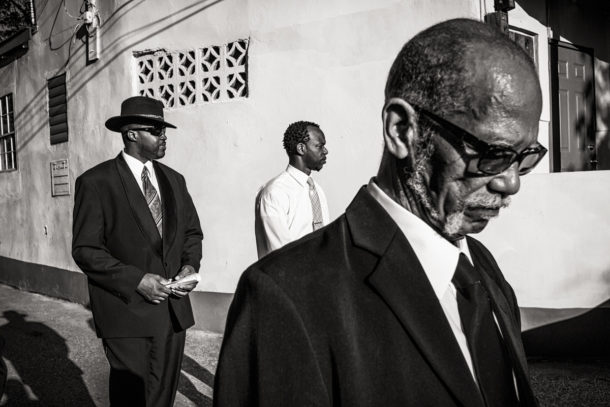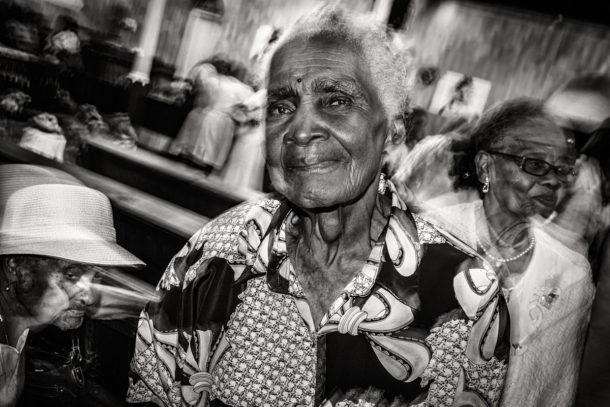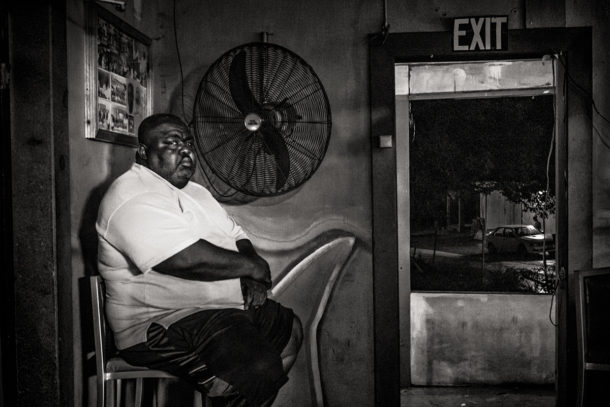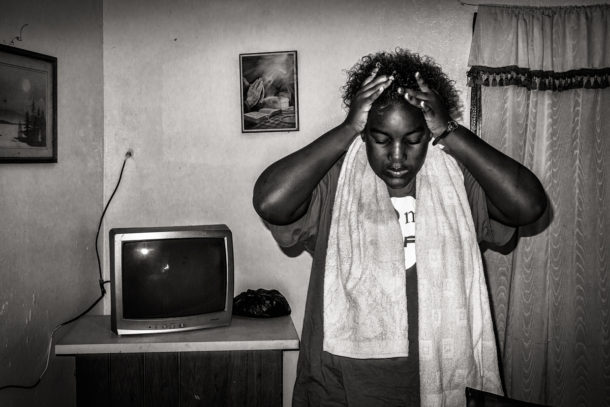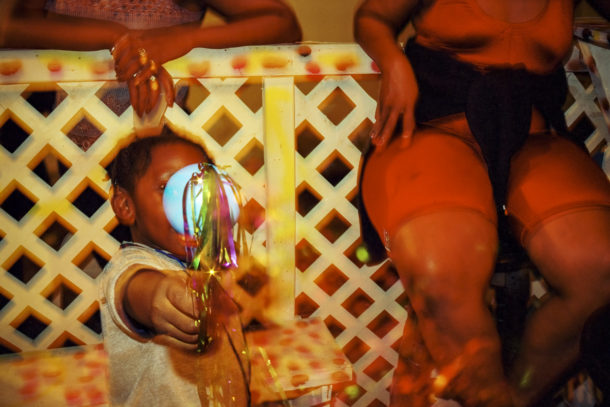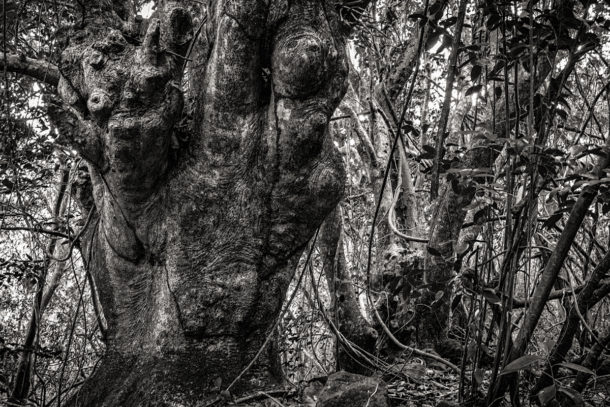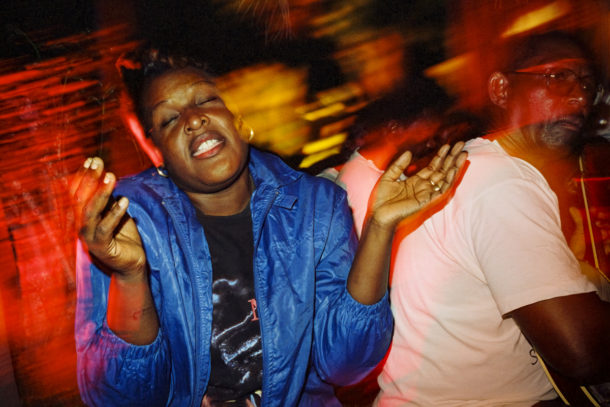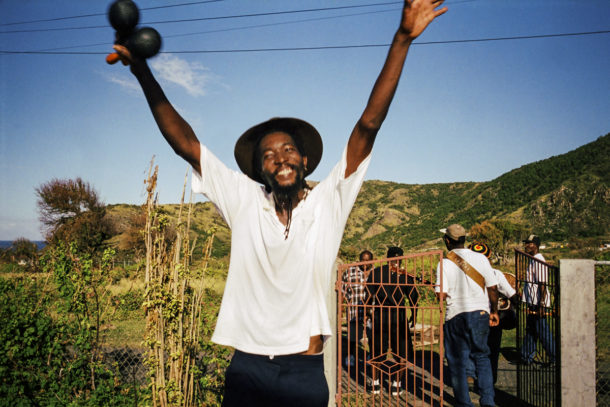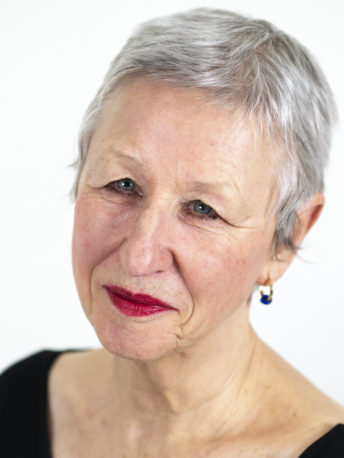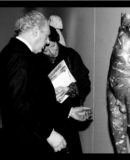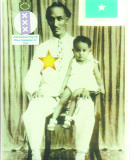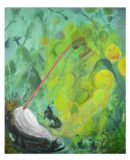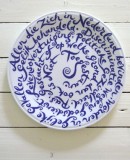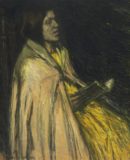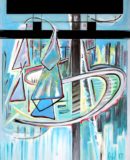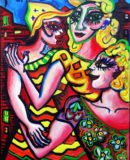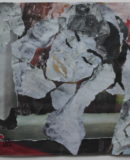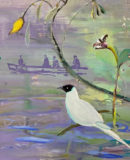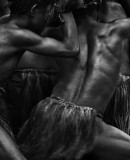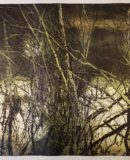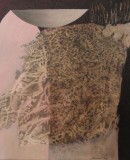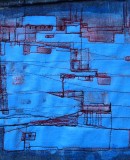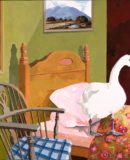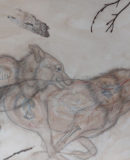World Fine Art Professionals and their Key-Pieces, 374 - Jeanette Bos
World Fine Art Professionals and their Key-Pieces, 374 – Jeanette Bos
I walk with Jeanette Bos past her photos in the Statia Song exhibition. It is a photographic ode to the island and the community of St. Eustatius.
Sint Eustatius, usually called Statia, is a tiny rocky island of 21 km2 in the Caribbean Sea. Together with Saba and Sint Maarten, it belongs to the Windward Islands. Since 1996, the island dominates Jeanette’s life.
Movement I
First we go to a black and white photo of children and an adult in the twilight with a sheep and a lamb. The lamb is sick. You can see the concern on their faces. The center of the image is sharp and around it is all movement. She used a flash. “At that moment you don’t know exactly what it will look like. You move along.” It is her favorite photo of this series, because of the intensity in the image and the movement. An image that made her feel: “I want to continue on this road!”
A new family
We continue to a photo of her friend Riena, who is considered Jeanette’s stepdaughter on Statia because she had a long relationship with Riena’s father, the leader of the Statian string band. It is a color photo, Riena sings and claps with closed eyes, as if in trance. “Caribbean string bands play traditional music from the islands: calypso. This band was still performing twice a week at the turn of the century, but then an American medical school with hundreds of students came and wanted karaoke. Suddenly the band was out of work and since then they only play around Christmas and on special occasions. All kinds of traditional instruments that I still knew have disappeared, such as the baho and the fife. The band is mostly made up of family members, and they have become my family over the years as well.”
Music
At the very end of the exhibition we see the string band – in color – on the back, they walk out of a gate, the maracas player has turned and looks at us, the maracas in the air. The band mainly played old-fashioned calypso. Jeanette became fascinated by it. She never liked relaxed music, but on Statia she experienced how much traditional music meant to people and became interested. The songs are full of social and political criticism. She started collecting classical calypso and immersed herself in its history, its African origin. At one point she got a Caribbean banjo, her boyfriend was teaching her. After two years of intensive study “…I saw the band before their performance sitting in a semicircle as usual, but now with one empty chair on which their cuatro lay. ‘You must play!'” Since then she has been a member of the band and she plays along on all occasions. She is also a member of a group of women who sing songs in people’s homes during the vigil the night before a funeral.
How did she end up on the island?
“I first came to Statia in 1996 when I was working on my first book. That was about the life of Antillean migrants and was centered around Hoogvliet, where many Antilleans lived and where I had previously done scientific research for the Ministry of Justice. During that research I became fascinated by what I saw and I took up photography. That’s how I really got into their world. In a family I had a lot to do with, the grandmother passed away and I was allowed to photograph the funeral and the preparations. Then I learned that the great-grandmother of the family was still alive and living on Sint Maarten. She would soon be celebrating her 100th birthday and everyone was saving to be able to attend. ‘Will you come with us?’ they asked.”
And she did. She traveled with the family across the Netherlands Antilles for six weeks. Her first book, Speransa, was published in 1998.
Relaxed
In the Windward Islands she had immediately fallen for the island of Statia, although at first sight it seemed the least special island. “Saba is beautiful, but I experienced the division into a white village and a black village as uncanny. Sint Maarten has beautiful parts, but is also incredibly busy and chaotic. Statia immediately captivated me with his friendliness and relaxed messiness. Signs ‘Don’t Litter’ sticking up from mounds of rubbish and shards of glass in which the sun shines. People sitting on the street corner drinking a beer. I was able to join in on that. Then I knew: this will be my second book.”
In 1998 she came to Statia again. For four months she photographed there and immersed herself in island life. Since then she came back to the island almost every year, usually for a few months, but also several times for half a year. She became more and more established. In 2016 her book ‘Statia Song’ was finally finished, but she continues to travel to Statia.
A new world
She had discovered a new world, and was wandering all over the island. She made long trips through the rugged, inaccessible hills on one side of the island, over the stony prairies along the coast, and over the steep, bushy slopes of the 601-meter-high volcano with the almost 300-meter-deep crater on the other side of the island. The exhibition also includes landscape photos, including of an ancient tree surrounded by lianas.
But most important to her in this new world was Statian society – she was warmly absorbed into the close-knit fabric of the ancient, closely related Afro-Caribbean families. Everyone knew everyone, from childhood and from close by. The mutual familiarity was immense and that gave the mutual contact a special character.
Most of these families lived a few square kilometers, close together, on the lower middle part of the island between the hills and the mountain, in and near the village of Oranjestad, which is the capital. There, low on the island, are simple houses. The higher up the mountainside, the bigger the houses, and the largest houses, mostly owned by the Dutch and Americans, tower over everything.
A changing world
Over the years, Jeanette saw the island change. In 1996, on her first visit, there were 2,000 people living there, about 1,750 people of Afro-Caribbean origin, the remainder being Dutch doctors and teachers, employees of the American oil transhipment company, and American retirees.
The oil transshipment company expanded with new employees from all over the world, the number of retirees grew, as did the medical staff. The increasing pillarization brought more and smaller schools, secondary schools expanded, more teachers came. A large influx of immigrants came from the Dominican Republic. And in 2010, with the disintegration of the Netherlands Antilles, Statia as a special municipality came under Dutch administration and a new top layer of civil servants and businessmen arose who brought new funds and facilities – water pipes, for example – but also new rules and taxes.
In twenty years the population grew – purely through immigration – to 3200 inhabitants. The Afro-Caribbean families, still a vast majority in 1996, are now a minority and their traditions are quickly disappearing.
How did Jeanette actually become a photographer?
Through a range of other professions. Coming from an Orthodox Christian farming family, she went to High School and after that to Teaching College for two years and became a teacher at the age of 19. That didn’t suit her, she switched to an office job, obtained degrees in typing, shorthand and modern languages, and eventually became an executive secretary. After a few years she went to study pedagogy in Utrecht and graduated from the Philosophy and Historical Pedagogy department. “A lot of it was social history. And a lot of philosophy.”
Her father was shooting pictures. “We had to be neat for a photo, put on a Sunday dress and your hair well combed, sit still and smile. When I was 13 I was allowed to shoot a roll full of my father’s camera for the first time.” That was a Zeiss Ikon, 6×6, with rolls of 12 photos, the first link to her ultimate profession. “That’s how I learned it. I continued to photograph, but at the time I didn’t see it as art. I saw it as a craft.
Capturing what you see.”
During her studies she was a student assistant in Historical Pedagogy for many years at the Pedagogy sub-faculty. When she graduated, however, she initially went in a different direction: she became a translator. The first translation came from German and was a pedagogical book by Peter Petersen, the founder of Jenaplan education. She did it at the request of evening students who taught at a Jenaplan school.
She then got a part-time job as a university lecturer in Youth Studies in Utrecht. But translating tasted like more, and in addition to university work, she started translating again, initially for Bzztôh, later for Meulenhoff.
Translating is storytelling
“I translated ‘The Gift of Asher Lev’ and ‘Wanderings’ by Potok and ‘Our Father’ and ‘The War Against Women’ by among others. I have met both writers. As well as Kuki Gallmann from whom I translated ‘I dreamed of Africa’. That was a huge bestseller. I already attended photography courses and the proceeds allowed me to buy beautiful equipment.” The second link to her future profession.
After teaching in Utrecht, together with her then husband and colleague, she conducted research on behalf of the Ministry of Justice into the living conditions of Antillean young people and their relationship with crime. They often visited Hoogvliet, where a large group of Antilleans lived, and carried out participant observation, inspired by the sociologist James Spradley. Her husband – raised in Curaçao – spoke Papiamentu fluently and Jeanette learned it, but understanding the spoken language quickly was difficult and often she could only watch. She loved what she saw, and took her camera with her. She was soon invited to photograph baptisms and weddings in people’s homes. She later discovered that the anthropological movement in photography relied heavily on James Spradley – the third link to her future profession.
She experiences her various professions as a whole: it’s all about stories…
Movement II
In the autumn of 1991 – she was still living in Utrecht at the time – she started her first photography course, in a community center. This was followed by a number of courses at the AVS (Audio-Visual Sentrum) in Utrecht, with teachers such as landscape photographer Jan Voster and specialist in old techniques Harm Botman, and afterwards also at the Amsterdam Center for Photography (De Moor). In 1993 she took a year of reportage training at the FotoVakschool in Apeldoorn. Her background kept playing tricks on her for a long time, she started with good, schooly pictures. But gradually she found a way to greater freedom of expression and brought more and more movement and complexity to her photos. Jeanette: “Away from the obvious. I like messy, cluttered photos.” There are examples of this in the exhibition, but even more can be found in her new work, a series of Berlin landscapes that she shows me on her iPad and is also available on her website.
Images
1) Adventist funeral passes one of the oldest cafes on Statia, 2) Elsie – Atja – Thompson, 3) Fred Schmidt, 4) Loliann Bass, Riena Arnaud’s daughter, 5) Mona Dunkerque and her grandson Reinier Daniels, 6) Olton Berkel and his children bring home a sick lamb, 7) Old tree on the slope of Quill (volcano on Statia), 8) Riena Arnaud and George Dunkirk, members of the string band, 9) The Hippy Boyz at the end of Christmas night, 10) Jeanette Bos
https://jeanettebos.zenfolio.com/https://gallerywm.com/WP/jeanette-bos-statia-song-01-04-30-04-2022/https://ifthenisnow.eu/nl/verhalen/de-wereld-van-de-amsterdamse-kunstenaar-89-jeanette-bos
Disclaimer: The views, opinions and positions expressed within this guest article are those of the author Walter van Teeffelen alone and do not represent those of the Marbella Marbella website. The accuracy, completeness and validity of any statements made within this article are not guaranteed. We accept no liability for any errors, omissions or representations. The copyright of this content belongs to Walter van Teeffelen and any liability with regards to infringement of intellectual property rights remains with the author.

